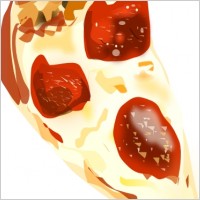
Ahhh! Picture the perfect pizza slice: steamy and sizzling, with stretchy cheese dripping from the edges as you lift it from the pan. Its savory scent entices you, as your mouth waters to welcome that first bite.
I LOVE pizza. (Bet you do too!) So I was intrigued when Scholastic asked me to report on the science behind pizza cheese for March’e SuperScience. 
My research brought me to materials engineer Bryony James, who is investigating the properties of pizza cheese. In her lab, at the University of Auckland in New Zealand, James has eight pizzas simmering. Each is topped with a different cheese. She wanted to find out what physical properties give pizza cheese those golden patches of toasty bubbles.
When James’s results were in, they explained why mozzarella is the pizza cheese champion. Mozzarella has just the right amounts of moisture, oil, and stretchiness to create that bubbly top that appeals to pizza lovers.
Here’s how the mouth-watering magic happens. When the pizza heats up, moisture evaporates to form steam. The steam expands the stretchy mozzarella to form bubbles. As the bubbles grow, oil slides off, allowing the bubbles to brown.
 Scientists like James have been studying pizza cheese for more than a century, because cheese makers are always seeking out improved varieties. For example, when U.S. cheese makers shipped mozzarella across the country, it spoiled. So scientists engineered a drier mozzarella that stays fresh longer. When faster pizza ovens were invented in the ’80s, cheese needed to be tweaked so it wouldn’t melt quickly and burn. Today, scientists are experimenting with making pizza cheese with less fat and sodium. Their challenge: make a healthier pizza that also tastes good.
Scientists like James have been studying pizza cheese for more than a century, because cheese makers are always seeking out improved varieties. For example, when U.S. cheese makers shipped mozzarella across the country, it spoiled. So scientists engineered a drier mozzarella that stays fresh longer. When faster pizza ovens were invented in the ’80s, cheese needed to be tweaked so it wouldn’t melt quickly and burn. Today, scientists are experimenting with making pizza cheese with less fat and sodium. Their challenge: make a healthier pizza that also tastes good.
If you want more historical information to chew on, read The Power of Pizza.
Here’s a question to whet your appetite:
Cultural historians believe pizza became popular in the United States after World War II because:
1. American G.I.s grew to like it while serving in Italy.
2. It was easy to eat in front of the newly invented TV.
3. Lots of cars enabled take-out, delivery, and road food.
4. 1, 2, and 3
See paragraph nine for the answer.
Still hungry for more cheese information? Click on James’s picture above to watch a video of her describing her experiments and/or read the NPR story.
You can view my school program/author visit video at:
SCHOOL PROGRAM / AUTHOR VISIT VIDEO
View or download my school program/author visit brochure at:
 AUTHOR PROGRAMS/VISITS BROCHURE
AUTHOR PROGRAMS/VISITS BROCHURE
See my husband’s and my photography at: http://www.agpix.com/cohen

